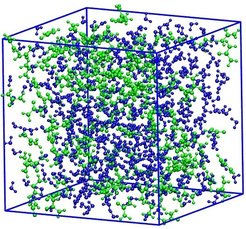Aqueous Urea Solution: Structure, Energetics, and Urea Aggregation
simila similibus solvuntur
Financial Support: Volkswagen Foundation
In virtually every biochemistry lab, urea is used as protein denaturant. However, despite its ubiquiteous use, only little is known about the molecular mechanism underlying urea-induced protein denaturation. To study structure and energetics of aqueous urea solutions, we have carried out molecular dynamics simulations. We found that urea fits structurally and sterically very well into the water network. However, hydrogen bond energies between urea molecules were found to be weaker than those between water molecules. This energy difference leads to urea self-aggregation (around 20%). Three preferred urea pair conformations could be identified. Further, the energy difference of the hydrogen bonds indicates that the mechanism of urea-induced protein denaturation might be entropically dominated via hydrophobic interactions. We hypothesize that urea might form interfaces between water and the urea-like backbone or less polar residues of the protein.

Urea pair conformations: Three preferential coordination positions (x,y,z) for urea molecules with respect to other urea molecules were distinguished (Fig. 1, top). Urea molecules at these positions showed strong orientational preferences (Fig. 1, middle). The size and sharpness of the distributions may be used to estimate accessible phase space and, hence, entropy. Figure 1 (bottom) shows the resulting three prevalent conformations (α, β, γ) for urea pairs. Conformation α was found to be the enthalpically most favored one as it features two hydrogen bonds. However, its accessible phase space and, hence, entropy, is relatively low and thus, its population was found to decline at higher temperatures. Conformation β formed only weak hydrogen bonds but the largest accessible phase space. As expected for such entropically favoured pairing, its population inclined at higher temperatures. Conformation γ was between α and β in terms of enthalpy and entropy.
Numbers and energies of the hydrogen bonds were analyzed between water and water, urea and water, and urea and urea. The total number of hydrogen bonds per water molecule was almost independent of urea concentration. In this respect, urea seemes to substitute well for water in the hydrogen bond network.
Although, geometrically, urea incorporates well into the hydrogen bond network, we found hydrogen bonds between urea and water to be significantly weaker than those between water molecules. The hydrogen bonds between urea molecules were even weaker. This progression in bond-strength caused a slight self-aggregation of urea due to the hydrophobic effect.

In the light of urea-induced protein denaturation, the weak urea hydrogen bonds point towards a preferential interaction of urea with less polar parts of the protein. Furthermore, it was found that the hydrogen bonds between water molecules become slightly stronger with increasing urea concentration. This imposes a stronger order on the water molecules. The strengthening effect of urea on water structure is expected to reduce the hydrophobic effect. Thus the entropic penalty to solvate apolar groups, such as the hydrophobic residues, which get exposed in the process of protein denaturation, is decreased. This more indirect interaction between urea and the protein might also facilitate protein denaturation.
Implications for the molecular mechanism of urea-induced protein denaturation: The tendency of urea to self-aggregate could point towards preferential interaction with the urea-like peptide backbone - as an instance of the well-known rule simila similibus solvuntur. Hence, a direct interaction of urea with the protein may be the dominant effect in protein denaturation. The strengthening of urea on water structure could also facilitate protein denaturation by a weakening of the hydrophobic effect.

